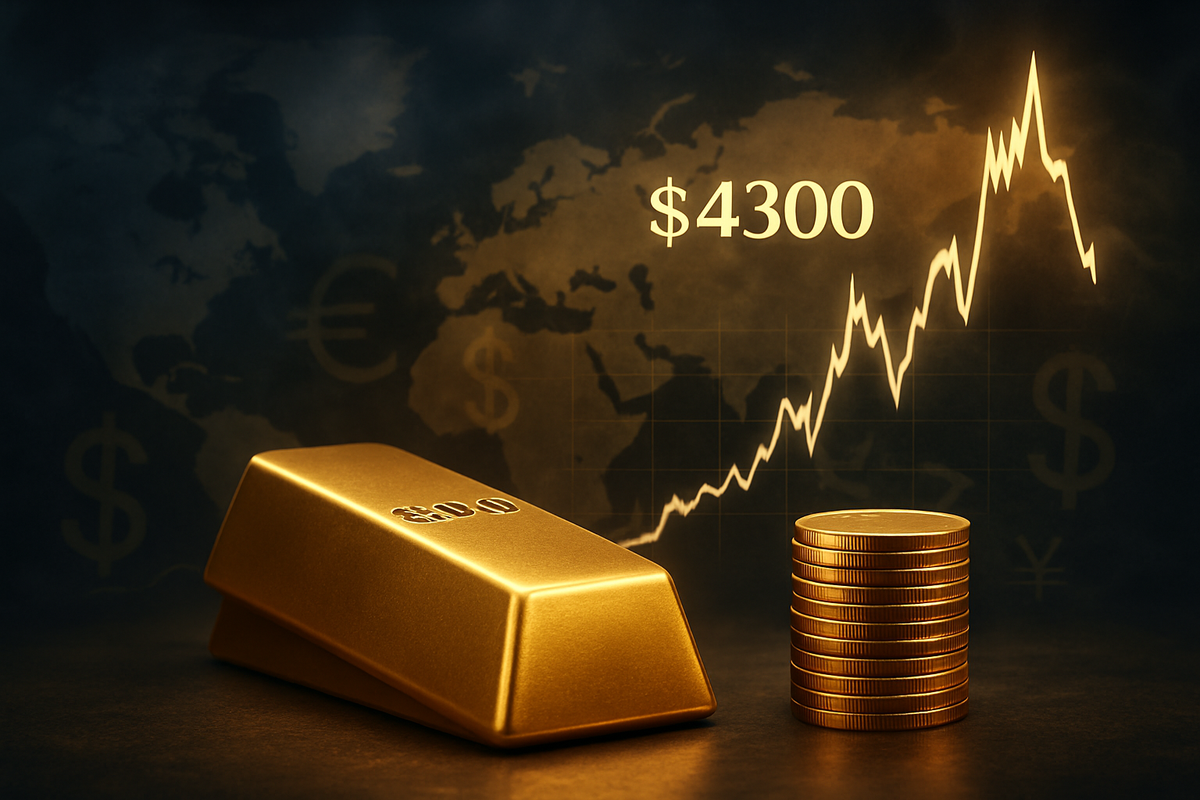
Gold has once again captured the financial world's attention, surging to an unprecedented high above $4300 per ounce on October 17, 2025, before experiencing a sharp, albeit temporary, dip later the same day. This record-breaking volatility underscores a market grappling with profound geopolitical and economic shifts, pushing the precious metal into uncharted territory and signaling a potent safe-haven appeal amidst global uncertainties. The rapid ascent and subsequent correction highlight both the immense bullish sentiment surrounding gold and the inherent risks of profit-taking in an overheated market.
This extraordinary price action carries significant implications for investors worldwide. The breach of the $4300 mark, a psychological and technical barrier, reflects a deep-seated demand for tangible assets as a hedge against inflation and instability. While the immediate pullback might trigger caution, the underlying factors driving gold's rally—ranging from escalating international tensions to dovish central bank policies—suggest that this could be more than just a fleeting moment of exuberance. Investors are now keenly watching whether gold can consolidate its gains or if further corrections are on the horizon, all while recalibrating their portfolios to navigate this new golden era.
Unpacking Gold's Rollercoaster Ride: A Day of Records and Reversals
The past 24 hours have been nothing short of historic for the gold market. On October 16, 2025, the precious metal made headlines by decisively crossing the $4300 per ounce threshold for the first time ever. This momentum accelerated into October 17, with spot gold prices rocketing to an all-time peak of approximately $4378.69 to $4379 per ounce during early Asian trading. U.S. gold futures for December delivery also mirrored this ascent, hitting a record high of $4391.69 per ounce. This monumental surge was fueled by a potent cocktail of global anxieties and strategic monetary policy expectations.
However, the euphoria was short-lived as the market demonstrated its characteristic volatility. Later on October 17, gold experienced a significant retraction, plunging by roughly $100 per ounce from its intraday high to settle around $4280 as London's 3pm auction approached. Spot gold was reported trading around $4230, easing from its record highs. This dip, which saw the price fall to $4283.06 USD/t.oz (a 1.05% decrease from the previous day's close), was primarily attributed to a rebounding U.S. Dollar and widespread profit-taking by traders capitalizing on the rapid gains. Despite this intraday correction, gold remained on track for its strongest weekly performance since the 2008 financial crisis, underscoring the powerful underlying bullish sentiment that continues to support its price.
Key players and stakeholders involved in this dynamic include central banks, which have been robust buyers of gold, and institutional investors funneling significant capital into gold-backed Exchange Traded Funds (ETFs). The timeline leading up to this moment has been characterized by escalating geopolitical tensions, particularly concerning trade relations between the United States and China, and growing concerns over rare earth element controls. Furthermore, strong market anticipation of aggressive interest rate cuts by the U.S. Federal Reserve has significantly bolstered gold's appeal, as lower interest rates reduce the opportunity cost of holding non-yielding assets. The ongoing U.S. government shutdown and emerging credit concerns within the U.S. regional banking sector have further exacerbated market uncertainty, driving investors towards the traditional safe haven of gold. The broader trend of de-dollarization is also cited as a contributing factor to gold's upward trajectory.
Initial market reactions have been a mix of awe and caution. While the record high signifies robust demand, the swift pullback serves as a reminder of gold's susceptibility to short-term corrections, especially when prices become overbought. Analysts from major financial institutions are increasingly revising their gold price forecasts upwards, with some now projecting prices to potentially reach $5000 per ounce by 2026. This suggests that despite the recent dip, the long-term outlook for gold remains strongly bullish, with many seeing the current volatility as a natural part of a larger upward trend rather than a fundamental reversal.
Companies on the Cusp: Winners and Losers in the Golden Rush
The recent surge and subsequent dip in gold prices create a dynamic landscape for various public companies, with clear winners and potential losers emerging. Gold mining companies, naturally, stand to benefit significantly from sustained high gold prices. Companies like Barrick Gold Corp. (NYSE: GOLD), Newmont Corporation (NYSE: NEM), and Agnico Eagle Mines Limited (NYSE: AEM) are poised to see increased revenues and profitability. Higher gold prices directly translate to fatter margins for miners, especially those with lower production costs. This surge could incentivize increased exploration and production, potentially leading to higher capital expenditures but also greater long-term value creation. Investors in these companies are likely experiencing a boost in their portfolio value, although the recent dip might introduce some short-term profit-taking pressure.
Conversely, companies that rely heavily on gold as an input for their products, such as certain luxury jewelry manufacturers or electronics companies, might face increased cost pressures. While many of these companies hedge their gold purchases, a sustained high price environment could erode their profit margins if they cannot pass on the increased costs to consumers. However, for well-established luxury brands, the prestige associated with gold might allow them to maintain pricing power. Retailers of gold products might also see fluctuating demand, with some consumers deterred by higher prices, while others, viewing gold as an investment, might increase their purchases during dips.
Financial institutions and investment firms with significant exposure to commodities, particularly gold, will also feel the ripple effects. Investment banks that facilitate gold trading and provide hedging services could see increased activity and revenue. Asset managers with gold-backed ETFs or precious metals funds, such as SPDR Gold Shares (NYSEARCA: GLD), will likely experience substantial inflows as investors flock to the safe haven. However, firms that are short gold or have incorrectly anticipated price movements could face losses. The increased volatility also presents opportunities for high-frequency trading firms and speculative investors who can capitalize on rapid price swings.
The broader economic implications also touch companies indirectly. In an environment of heightened geopolitical tensions and economic uncertainty, companies that are perceived as stable or defensive might see increased investor interest. This flight to safety, while directly benefiting gold, can also support sectors like utilities or established consumer staples. Conversely, companies heavily reliant on global trade or sensitive to economic downturns might face headwinds. The gold market's movements, therefore, serve as a barometer for broader economic sentiment, influencing investor appetite across various sectors and dictating capital flows into and out of different public companies.
The Wider Significance: A Barometer of Global Instability
Gold's dramatic price action is far more than a simple commodity fluctuation; it serves as a potent barometer of deeper, systemic shifts in the global economic and geopolitical landscape. This event fits squarely into broader industry trends emphasizing de-dollarization and a global search for alternative safe-haven assets. As nations and central banks diversify their reserves away from the U.S. dollar, gold naturally benefits. The record surge underscores a growing lack of confidence in traditional financial instruments and a flight towards tangible assets amidst a fragmented and uncertain world order. This trend is likely to persist as geopolitical fault lines deepen and economic nationalism gains traction.
The ripple effects on competitors and partners are substantial. For other precious metals like silver, platinum, and palladium, gold's surge often acts as a leading indicator, pulling their prices upwards in sympathy. This creates a rising tide for the entire precious metals mining sector. Furthermore, the perceived instability driving gold's rally can have significant implications for traditional reserve currencies and government bonds. If investors increasingly prefer gold over sovereign debt, it could put upward pressure on borrowing costs for governments and challenge the dominance of currencies like the U.S. dollar, the Euro, and the Yen. This dynamic could force central banks to re-evaluate their monetary policies and reserve management strategies.
Regulatory and policy implications are also noteworthy. Governments and international bodies might scrutinize the gold market more closely for signs of manipulation or excessive speculation, particularly if volatility continues to escalate. There could be renewed calls for greater transparency in gold trading or even discussions about central bank digital currencies (CBDCs) as a way to potentially offer an alternative stable asset, though this is a long-term consideration. The ongoing U.S. government shutdown, a key factor in gold's recent ascent, highlights the policy paralysis that can directly impact market sentiment and drive safe-haven demand, urging policymakers to find swift resolutions to avoid further economic uncertainty.
Historically, gold has always performed strongly during periods of high inflation, economic recession, and geopolitical turmoil. Comparisons can be drawn to the 1970s oil shocks, the dot-com bubble burst, and the 2008 financial crisis, all of which saw significant rallies in gold prices. The current environment, characterized by persistent inflation concerns, fears of a global economic slowdown, and escalating conflicts, mirrors these historical precedents. The difference now is the unprecedented scale of central bank liquidity, the interconnectedness of global markets, and the added layer of digital asset competition. This confluence of factors suggests that gold's role as a hedge and store of value is not just a cyclical phenomenon but a potentially structural shift in global finance.
What Comes Next: Navigating the Golden Path Ahead
Looking ahead, the gold market is poised for continued dynamism, offering both significant opportunities and challenges for investors. In the short-term, further volatility is highly probable. The recent dip, driven by profit-taking and a U.S. Dollar rebound, indicates that while the underlying bullish sentiment is strong, the market remains susceptible to corrections after rapid advances. Investors should anticipate potential consolidation phases where gold's price might stabilize or retest support levels before attempting new highs. The immediate focus will be on upcoming economic data releases, any shifts in Federal Reserve rhetoric regarding interest rates, and developments in global geopolitical flashpoints.
Long-term possibilities for gold remain overwhelmingly positive, with many analysts forecasting a sustained uptrend. The structural drivers—including persistent inflation concerns, ongoing de-dollarization efforts by central banks, and the enduring appeal of gold as a safe haven amidst global instability—are unlikely to dissipate quickly. Should central banks, particularly the U.S. Federal Reserve, proceed with aggressive rate cuts as anticipated, the opportunity cost of holding non-yielding gold will further decrease, making it an even more attractive asset. This environment could see gold comfortably establish a new trading range well above its historical averages, potentially pushing towards the $5000 per ounce mark by 2026, as some experts predict.
Potential strategic pivots or adaptations required by market participants are crucial. Gold miners might accelerate expansion plans, invest in new technologies to lower production costs, or engage in mergers and acquisitions to consolidate resources. Investors, on the other hand, might diversify their gold exposure through a mix of physical gold, gold-backed ETFs, and shares in mining companies to mitigate risk and capitalize on different facets of the market. The emergence of digital gold tokens and other blockchain-based precious metal assets could also gain traction, offering new avenues for investment and liquidity, though regulatory frameworks for these are still evolving.
Market opportunities will likely emerge during any significant dips, presenting buying opportunities for long-term investors. Conversely, the challenges include managing the inherent volatility, especially for short-term traders, and the risk of unexpected shifts in monetary policy or geopolitical de-escalation that could temper gold's appeal. Potential scenarios range from a sustained, gradual ascent driven by a weakening dollar and continued global uncertainty to more erratic, stair-step movements marked by sharp rallies and subsequent profit-taking corrections. The overarching outcome, however, points towards gold playing an increasingly central role in global portfolios as a fundamental hedge against an unpredictable future.
A Golden Future: Navigating a New Era of Market Dynamics
Gold's recent record-breaking surge above $4300 and its subsequent dip encapsulate a pivotal moment in financial markets, highlighting the precious metal's enduring role as a beacon of stability amidst profound global turbulence. The key takeaways from this event are manifold: gold's safe-haven appeal is stronger than ever, driven by a confluence of geopolitical tensions, dovish monetary policy expectations, and economic uncertainties; central bank and institutional demand remains robust; and while short-term corrections are inevitable, the long-term bullish outlook for gold appears firmly entrenched. The rapid ascent and immediate pullback underscore the dynamic nature of the market, where fundamental drivers meet technical trading pressures.
Moving forward, the market is poised for continued evolution, with gold likely maintaining a prominent position in investor portfolios. The factors that propelled gold to its current heights—including the U.S. government shutdown, regional banking concerns, and the broader trend of de-dollarization—are not fleeting issues but rather structural shifts that will continue to influence asset allocation decisions. While the immediate focus might be on price consolidation, the underlying narrative points towards a sustained re-evaluation of gold's intrinsic value in a world grappling with inflation, geopolitical fragmentation, and the erosion of trust in traditional fiat currencies.
The lasting impact of this event will likely be a reinforced belief in gold as a critical component of a diversified investment strategy. It serves as a stark reminder that in times of crisis, tangible assets often outperform, providing a crucial hedge against systemic risks. The $4300 mark, though briefly surpassed and then retreated from, has established a new psychological benchmark, signaling a new era for gold pricing. This is not merely a transient spike but a reflection of deep-seated market forces at play, suggesting that gold's journey to higher valuations is far from over.
Investors should watch for several key indicators in the coming months. These include further pronouncements from the U.S. Federal Reserve regarding interest rates, any de-escalation or intensification of geopolitical conflicts, particularly involving major global powers, and the ongoing performance of the U.S. Dollar. Additionally, monitoring central bank gold purchases and ETF inflows will provide insights into sustained institutional demand. Ultimately, the message is clear: gold has entered a new chapter, and understanding its drivers will be paramount for navigating the complex financial landscape ahead.
This content is intended for informational purposes only and is not financial advice





